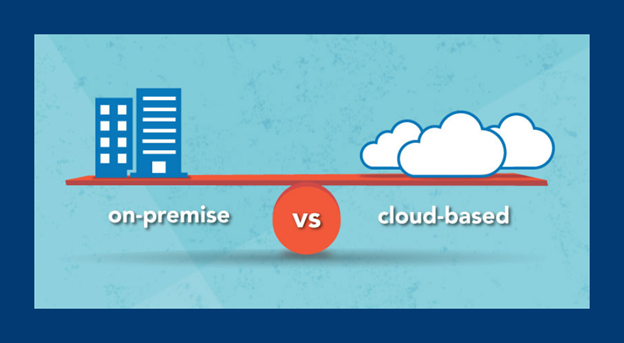
Key Differences of On Premise vs. Cloud
There are several fundamental differences between an on-premises and a cloud environment. Which path is the correct one for your enterprise depends entirely on your needs and what it is you’re looking for on a solution?
‘The cloud’ has grown in popularity in recent years and, according to Gartner, worldwide end-user spending on public cloud services is forecast to grow 18.4% in 2021 to a total of $304.9 billion, up from $257.5 billion in 2020.
Cloud vs On-Premise Software Comparison
Essentially, the fundamental difference between cloud vs on-premise software is where it resides.
On-premise software is installed locally, on your business’ computers and servers, where cloud software is hosted on the vendor’s server and accessed via a web browser.
As well as accessibility, there are a raft of other things that need to be considered when making a decision, including software ownership, cost of ownership, software updates and additional services, such as support and implementation.
Deployment
On Premises: In an on-premises environment, resources are deployed in-house and within an enterprise’s IT infrastructure. An enterprise is responsible for maintaining the solution and all its related processes.
Cloud: While there are different forms of cloud computing (such as public cloud, private cloud, and a hybrid cloud), in a public cloud computing environment, resources are hosted on the premises of the service provider but enterprises are able to access those resources and use as much as they want at any given time.
Cost
On Premises: For enterprises that deploy software on premise, they are responsible for the ongoing costs of the server hardware, power consumption, and space.
Cloud: Enterprises that select to use a cloud computing model only need to pay for the resources that they use, with none of the maintenance and upkeep costs, and the price adjusts depending on how much is consumed.
Costs. Cloud-based solutions tend to cost less than on-premises solutions the first year. On-premises-based systems are priced under a one-time perpetual license fee, usually based on the number of concurrent users accessing the system.
Control
On Premises: In an on-premises environment, enterprises retain all their data and are fully in control of what happens to it, for better or worse. Companies in highly regulated industries with extra privacy concerns are more likely to hesitate to leap into the cloud before others because of this reason.
Cloud: In a cloud computing environment, the question of ownership of data is one that many companies – and vendors for that matter, have struggled with. Data and encryption keys reside within your third-party provider, so if the unexpected happens and there is downtime, you maybe be unable to access that data.
System updates and customizations. Cloud-based system vendors provide software updates to their customers throughout the year. On-premises vendors also provide updates in a timely fashion. However, the updates are not automatic, and the organization needs to be on a maintenance plan to be able to download the updates.
Security
On Premises: Companies that have extra sensitive information, must have a certain level of security and privacy that an on-premises environment provides. Despite the promise of the cloud, security is the primary concern for many industries, so an on-premises environment, despite some of its drawbacks and price tag, make more sense.
Cloud: Security concerns remain the number one barrier to cloud computing deployment. There have been many publicized cloud breaches, and IT departments around the world are concerned. From personal information of employees such as login credentials to a loss of intellectual property, the security threats are real.
Security and data. Cloud vendors make security and protection of your data top priority. In addition, cloud providers offer disaster recovery and back up procedures. On-premises security is the responsibility of the organization, not the vendor. Since is installed on premise, data access can be monitored and controlled locally.
Compliance
On Premises: Many companies these days operate under some form of regulatory control, regardless of the industry. For companies that are subject to such regulations, it is imperative that they remain compliant and know where their data is at all times.
Cloud: Enterprises that do choose a cloud computing model must do their due diligence and ensure that their third-party provider is up to code and in fact compliant with all the different regulatory mandates within their industry. Sensitive data must be secured, and customers, partners, and employees must have their privacy ensured.
Conclusion
Whether it may be on cloud or on-premises, it is important that you consider what you need, your capability to sustain & manage, which one will better bring efficiency from the work force.



